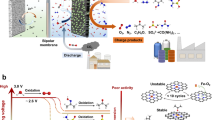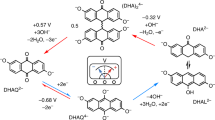Abstract
As our reliance on renewable energy sources grows, so too does our need to store this energy to mitigate against troughs in supply. Energy storage in batteries or by conversion to chemical fuels are the two most flexible and scalable options, but are normally considered mutually exclusive. Energy storage solutions that can act as both batteries and fuel generation devices (depending on the requirements of the user) could therefore revolutionize the uptake and use of renewably generated energy. Here, we present a polyoxoanion, [P2W18O62]6−, that can be reversibly reduced and protonated by 18 electrons/H+ per anion in aqueous solution, and that can act either as a high-performance redox flow battery electrolyte (giving a practical discharged energy density of 225 Wh l−1 with a theoretical energy density of more than 1,000 Wh l−1), or as a mediator in an electrolytic cell for the on-demand generation of hydrogen.
This is a preview of subscription content, access via your institution
Access options
Access Nature and 54 other Nature Portfolio journals
Get Nature+, our best-value online-access subscription
$29.99 / 30 days
cancel any time
Subscribe to this journal
Receive 12 print issues and online access
$259.00 per year
only $21.58 per issue
Buy this article
- Purchase on Springer Link
- Instant access to full article PDF
Prices may be subject to local taxes which are calculated during checkout




Similar content being viewed by others
References
Dunn, B., Kamath, H. & Tarascon, J.-M. Electrical energy storage for the grid: a battery of choices. Science 334, 928–935 (2011).
Cook, T. R. et al. Solar energy supply and storage for the legacy and nonlegacy worlds. Chem. Rev. 110, 6474–6502 (2010).
Roger, I., Shipman, M. A. & Symes, M. D. Earth-abundant catalysts for electrochemical and photoelectrochemical water splitting. Nat. Rev. Chem. 1, 0003 (2017).
Hanley, E. S., Amarandei, G. & Glowacki, B. A. Potential of redox flow batteries and hydrogen as integrated storage for decentralized energy systems. Energy Fuels 30, 1477–1486 (2016).
Halls, J. E. et al. Empowering the smart grid: can redox batteries be matched to renewable energy systems for energy storage? Energy Environ. Sci. 6, 1026–1041 (2013).
Posada, J. O. G. et al. Aqueous batteries as grid scale energy storage solutions. Renew. Sustain. Energy Rev. 68, 1174–1182 (2017).
Alotto, P., Guarnieri, M. & Moro, F. Redox flow batteries for the storage of renewable energy: a review. Renew. Sustain. Energy Rev. 29, 325–335 (2014).
Olah, G. A., Prakash, G. K. S. & Goeppert, A. Anthropogenic chemical carbon cycle for a sustainable future. J. Am. Chem. Soc. 133, 12881–12898 (2011).
Le Formal, F., Bourée, W. S., Prévot, M. S. & Sivula, K. Challenges towards economic fuel generation from renewable electricity: the need for efficient electrocatalysis. Chimia 69, 789–798 (2015).
Carmo, M., Fritz, D. L., Mergel, J. & Stolten, D. A comprehensive review on PEM water electrolysis. Int. J. Hydrog. Energy 38, 4901–4934 (2013).
Symes, M. D. & Cronin, L. Decoupling hydrogen and oxygen evolution during electrolytic water splitting using an electron-coupled-proton buffer. Nat. Chem. 5, 403–409 (2013).
Rausch, B., Symes, M. D., Chisholm, G. & Cronin, L. Decoupled catalytic hydrogen evolution from a molecular metal oxide redox mediator in water splitting. Science 345, 1326–1330 (2014).
Guinot, B. et al. Techno-economic study of a PV–hydrogen-battery hybrid system for off-grid power supply: impact of performances’ ageing on optimal system sizing and competitiveness. Int. J. Hydrog. Energy 40, 623–632 (2015).
Pellow, M. A., Emmott, C. J. M., Barnhart, C. J. & Benson, S. M. Hydrogen or batteries for grid storage? A net energy analysis. Energy Environ. Sci. 8, 1938–1952 (2015).
Peljo, P. et al. All-vanadium dual circuit redox flow battery for renewable hydrogen generation and desulfurization. Green Chem. 18, 1785–1797 (2016).
Mulder, F. M., Weninger, B. M. H., Middelkoop, J., Ooms, F. G. B. & Schreuders, H. Efficient electricity storage with a battolyser, an integrated Ni–Fe battery and electrolyser. Energy Environ. Sci. 10, 756–764 (2017).
Pope, M. T. Heteropoly and Isopoly Oxometalates (Springer, Heidelberg, 1983).
Papaconstantinou, E. & Pope, M. T. Heteropoly blues. III. Preparation and stabilities of reduced 18-molybdodiphosphates. Inorg. Chem. 6, 1152–1155 (1967).
Launay, J. P. Reduction de l’ion metatungstate: stades eleves de reduction de H2W12O40 6−, derives de l’ion HW12O40 7− et discussion generale. J. Inorg. Nucl. Chem. 38, 807–16 (1976).
Way, D. M., Bond, A. M. & Wedd, A. G. Multielectron reduction of α-[S2Mo18O62]4– in aprotic and protic media: voltammetric studies. Inorg. Chem. 36, 2826–2833 (1997).
Bond, A. M., Vu, T. & Wedd, A. G. Voltammetric studies of the interaction of the lithium cation with reduced forms of the Dawson [S2Mo18O62]4– polyoxometallates anion. J. Electroanal. Chem. 494, 96–104 (2000).
Takamoto, M., Ueda, T. & Himeno, S. Solvation effect of Li+ on the voltammetric properties of [PMo12O40]3− in binary solvent mixtures. J. Electroanal. Chem. 521, 132–136 (2002).
Grigoriev, V. A., Cheng, D., Hill, C. L. & Weinstock, I. A. Role of alkali metal cation size in the energy and rate of electron transfer to solvent-separated 1:1 [(M+)(acceptor)] (M+ = Li+, Na+, K+) ion pairs. J. Am. Chem. Soc. 123, 5292–5307 (2001).
Ueda, T. et al. Voltammetric behavior of 1- and 4-[S2VVW17O62]5− in acidified acetonitrile. Dalton Trans. 44, 11660–11668 (2015).
Ji, Y., Huang, L., Hu, J., Streb, C. & Song, Y.-F. polyoxometallates-functionalized nanocarbon materials for energy conversion, energy storage and sensor systems. Energy Environ. Sci. 8, 776–789 (2015).
Wang, H. et al. In operando X-ray absorption fine structure studies of polyoxometallates molecular cluster batteries: polyoxometallates as electron sponges. J. Am. Chem. Soc. 134, 4918–4924 (2012).
Nishimoto, Y., Yokogawa, D., Yoshikawa, H., Awaga, K. & Irle, S. Super-reduced polyoxometallates: excellent molecular cluster battery components and semipermeable molecular capacitors. J. Am. Chem. Soc. 136, 9042–9052 (2014).
Chen, J.-J. et al. High-performance polyoxometallates-based cathode materials for rechargeable lithium-ion batteries. Adv. Mater. 27, 4649–4654 (2015).
Huang, Q. et al. A highly stable polyoxometallates-based metal–organic framework with π–π stacking for enhancing lithium ion battery performance. J. Mater. Chem. A 5, 8477–8483 (2017).
Chen, J.-J. et al. Design and performance of rechargeable sodium ion batteries, and symmetrical Li-ion batteries with supercapacitor-like power density based upon polyoxovanadates. Adv. Energy Mater. 7, 1701021 (2017).
Hartung, S. et al. Vanadium-based polyoxometallates as new material for sodium-ion battery anodes. J. Power Sources 288, 270–277 (2015).
Pratt, H. D. III, Hudak, N. S., Fang, X. & Anderson, T. M. A polyoxometallates flow battery. J. Power Sources 236, 259–264 (2013).
Pratt, H. D. III & Anderson, T. M. Mixed addenda polyoxometallates ‘solutions’ for stationary energy storage. Dalton Trans. 42, 15650–15655 (2013).
Chen, J.-J. J. & Barteau, M. A. Molybdenum polyoxometallates as active species for energy storage in non-aqueous media. J. Energy Storage 13, 255–261 (2017).
VanGelder, L. E., Kosswattaarachchi, A. M., Forrestel, P. L., Cook, T. R. & Matson, E. M. Polyoxovanadate-alkoxide clusters as multi-electron charge carriers for symmetric non-aqueous redox flow batteries. Chem. Sci. 9, 1692–1699 (2018).
Liu, Y. et al. An aqueous redox flow battery with a tungsten–cobalt heteropolyacid as the electrolyte for both the anode and cathode. Adv. Energy Mater. 7, 1601224 (2017).
Kato, C. et al. Quick and selective synthesis of Li6[α-P2W18O62]·28H2O soluble in various organic solvents. Dalton Trans. 42, 11363–11366 (2013).
Bernardini, G., Wedd, A. G. & Bond, A. M. Reactivity of one-, two-, three- and four-electron reduced forms of α-[P2W18O62]6− generated by controlled potential electrolysis in water. Inorg. Chim. Acta 374, 327–333 (2011).
Pope, M. T. & Papaconstantinou, E. Heteropoly blues. II. Reduction of 2:18-tungstates. Inorg. Chem. 6, 1147–1152 (1967).
Harmalker, S. P., Leparulo, M. A. & Pope, M. T. Mixed-valence chemistry of adjacent vanadium centers in heteropolytungstate anions. I. Synthesis and electronic structures of mono-, di-, and trisubstituted derivatives of α-[P2W18O62]6−. J. Am. Chem. Soc. 105, 4286–4292 (1983).
Keita, B. & Nadjo, L. New aspects of the electrochemistry of heteropolyacids part IV. Acidity dependent cyclic voltammetric behaviour of phosphotungstic and silicotungstic heteropolyanions in water and N,N-dimethylformamide. J. Electroanal. Chem. 227, 77–98 (1987).
Prenzler, P. D., Boskovic, C., Bond, A. M. & Wedd, A. G. Coupled electron- and proton-transfer processes in the reduction of α-[P2W18O62]6− and α-[H2W12O40]6− as revealed by simulation of cyclic voltammograms. Anal. Chem. 71, 3650–3656 (1999).
Bernardini, G., Zhao, C., Wedd, A. G. & Bond, A. M. Ionic liquid-enhanced photooxidation of water using the polyoxometallates anion [P2W18O62]6− as the sensitizer. Inorg. Chem. 50, 5899–5909 (2011).
Wang, M., Zhao, F. & Dong, S. A single ionic conductor based on Nafion and its electrochemical properties used as lithium polymer electrolyte. J. Phys. Chem. B 108, 1365–1370 (2004).
Millet, P. et al. PEM water electrolyzers: from electrocatalysis to stack development. Int. J. Hydrog. Energy 35, 5043–5052 (2010).
Xu, C., Ma, L., Li, J., Zhao, W. & Gan, Z. Synthesis and characterization of novel high-performance composite electrocatalysts for the oxygen evolution in solid polymer electrolyte (SPE) water electrolysis. Int. J. Hydrog. Energy 37, 2985–2992 (2012).
Huskinson, B. et al. A metal-free organic–inorganic aqueous flow battery. Nature 505, 195–198 (2014).
Lin, K. et al. Alkaline quinone flow battery. Science 349, 1529–1532 (2015).
Janoschka, T. et al. An aqueous, polymer-based redox-flow battery using non-corrosive, safe, and low-cost materials. Nature 527, 78–81 (2015).
Li, L. et al. A stable vanadium redox-flow battery with high energy density for large-scale energy storage. Adv. Energy Mater. 1, 394–400 (2011).
Mohamed, M. R., Sharkh, S. M. & Walsh, F. C. Redox flow batteries for hybrid electric vehicles: progress and challenges. IEEE Veh. Power Propuls. Conf. 09, 551–557 (2009).
Leung, P. et al. Progress in redox flow batteries, remaining challenges and their applications in energy storage. RSC Adv. 2, 10125–10156 (2012).
Acknowledgements
The authors thank Q. Zheng (University of Glasgow) for assistance with mass spectrometry and NMR. M.D.S. thanks the Royal Society for a University Research Fellowship. The authors acknowledge funding from the EPSRC (grant nos. EP/H024107/1, EP/J00135X/1, EP/J015156/1, EP/K021966/1, EP/K023004/1 and EP/L023652/1), the EC (318671 MICREAGENTS) and ERC (project 670467 SMART-POM).
Author information
Authors and Affiliations
Contributions
L.C. conceived the concept and, together, L.C., J.J.C. and M.D.S. expanded the hypothesis, planned experiments and wrote the paper. J.J.C. performed all the electrochemistry experiments and analysis.
Corresponding authors
Additional information
Publisher’s note: Springer Nature remains neutral with regard to jurisdictional claims in published maps and institutional affiliations.
Supplementary information
Supplementary Information
Supplementary Methods, Supplementary Characterization, Supplementary Data, Supplementary Figures 1–26, Supplementary Tables 1–5
Rights and permissions
About this article
Cite this article
Chen, JJ., Symes, M.D. & Cronin, L. Highly reduced and protonated aqueous solutions of [P2W18O62]6− for on-demand hydrogen generation and energy storage. Nature Chem 10, 1042–1047 (2018). https://doi.org/10.1038/s41557-018-0109-5
Received:
Accepted:
Published:
Issue Date:
DOI: https://doi.org/10.1038/s41557-018-0109-5
This article is cited by
-
A highly reduced Mo74 polyoxometalate featuring high proton conductivity accessed by building block strategy
Science China Chemistry (2024)
-
Sub-nanosized vanadate hybrid clusters maintain glucose homeostasis and restore treatment response in inflammatory disease in obese mice
Nano Research (2024)
-
Recent Advances in High-Efficiency Electrocatalytic Water Splitting Systems
Electrochemical Energy Reviews (2023)
-
Working in the cold
Nature Energy (2022)
-
Emerging chemistries and molecular designs for flow batteries
Nature Reviews Chemistry (2022)



